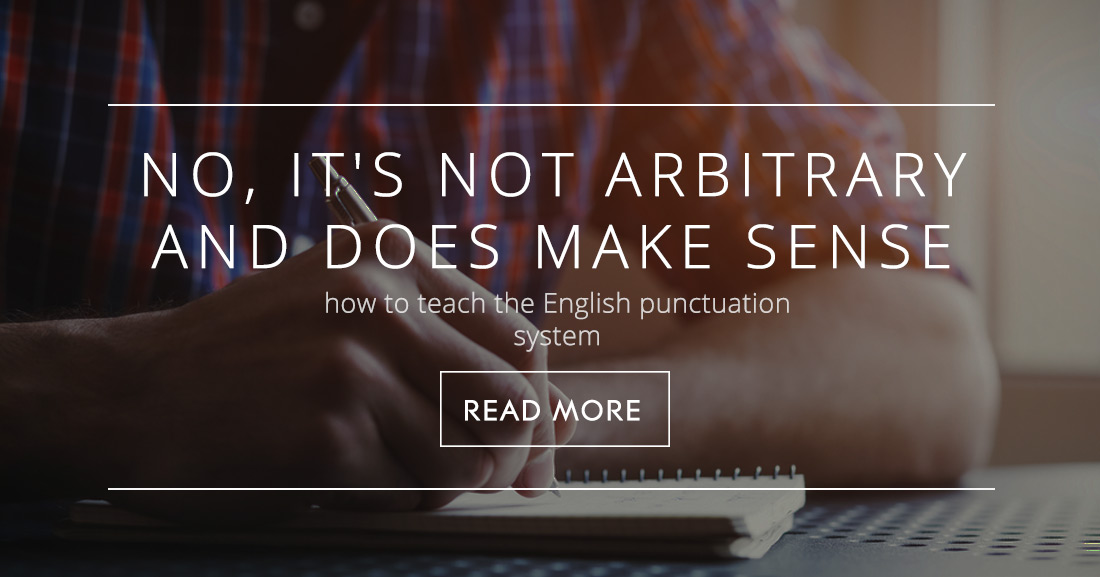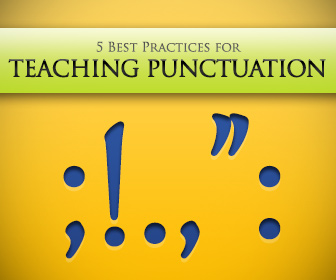No, It's Not Arbitrary and Does Make Sense: How to Teach the English Punctuation System


“Well, can you show me where you’d like to use it?” I asked. “But what is it?” “It’s a dot on top and comma below.” “No, I mean, what’s it for?” “You need to show me where you’d like to use it….” and so on. This kind of conversation is typical when talking about punctuation. It highlights why it’s so difficult to teach and learn correct punctuation: it’s near impossible to teach outside of the context of written text, and it is full of difficult terminology (independent clause, dependent clause, introductory phrase, etc.) foreign to most learners. However, there are several methods a teacher can rely on to teach punctuation and sharpen students’ grammar skills at the same time.

A period goes at the end of a thought. A comma marks a “breath.” A colon is stronger than a comma but not quite as strong as a period…and so on. “Rules” of punctuation are filled with such myths and elements impossible to measure as “thoughts” and “breaths” and “strong” and “weak,” probably because at some point in students’ education it was easier to talk about breaths and thoughts than about independent and dependent clauses and coordinating conjunctions, which is really how punctuation is actually used.
It’s not possible to teach punctuation without teaching independent and dependent clauses and coordinating and subordinating conjunctions, as it is these grammatical elements that punctuation actually marks—a period demonstrates the end of an independent clause, or simple sentence, for example—so teaching punctuation is also a good opportunity to review sentence construction and variety. For example, one exercise I like to use is after teaching some of the basic rules of punctuation use, giving students a passage from a well-known story, with all the complex and compound sentences changed to simple sentences. For example, one of the opening paragraphs of F. S. Fitzgerald’s The Great Gatsby goes from “The practical thing was to find rooms in the city, but it was a warm season, and I had just left a country of wide lawns and friendly trees, so when a young man at the office suggested that we take a house together in a commuting town, it sounded like a great idea….” to “The practical thing was to find rooms in the city. It was a warm season. I had just left a country of wide lawns and friendly trees. A young man at the office suggested that we take a house together in a commuting town. It sounded like a great idea.” Give students the revised version without showing the original, discuss why it is ineffective—e.g., the causal relationships have all been deleted—and see if they can work to combine sentences and improve the passage. Then have them compare their revisions with their original by Fitzgerald.
I emphasize to my students that correct grammar, usage, and punctuation are not ends in themselves—they are not the purpose of written communication—rather they are part of the means of communicating a message. For example, the reader of the revised Fitzgerald passage above is likely to have trouble seeing the relationship between having just left a rural area and the decision to take a house outside of the city because the coordination and subordination, and their related punctuation, have been removed, causing a gap in communication. Knowing how to vary sentences with standard punctuation helps assist the reader in understanding the message, in other words.
One of the reasons I use classic and contemporary passages like “The Great Gatsby” is that it’s very difficult to talk about grammar and punctuation without placing it in some kind of context, which is why it was hard to answer my daughter when she asked, “What is a semi-colon for?” I could have answered “It’s used to connect two independent clauses, and also to connect two independent clauses with a coordinating phrase…” which, I suspect, would mean little to her. That is why I asked to see her paper, to show her how she would use the semi-colon in the context of the ideas she was trying to communicate. Most importantly, however, the student should be told to not worry very much about semi-colons in the first draft, as she is just getting her ideas down at this point, and the sentences are likely to change in any case in later drafts.
Finally, punctuation really should be related to that final stage of writing: the editing, proofreading, and polishing that go on after all the ideas are arranged on the paper in coherent sentences. It is at this point that the student can look critically at a paper and make decisions about where a simple or a more complex sentence would be more effective, or whether to connect two independent clauses with a semi-colon or with a conjunction and period. That this stage of editing comes last does not make it of lesser importance, of course—it is Fitzgerald’s masterful use of sentence structure and variety, for example, that in part distinguishes him from lesser writers.
However, correct punctuation is not the end goal of writing itself, and it should be taught in the context of communicating a message with authority to a reader.